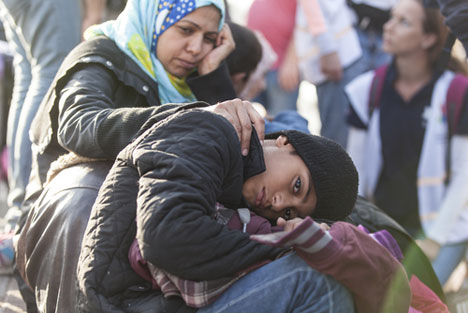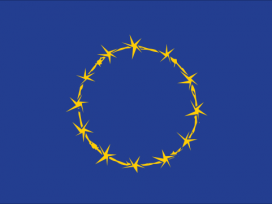This summer Europe woke up to find a population the size of a small nation knocking on its door. The refugee problem that has lingered for so long on our borders is now a refugee “crisis”. In Pakistan, Lebanon, Jordan, Turkey, Ethiopia and Iran, it’s been something more than that for quite some time. Suddenly Europe has discovered that it is much more intimately connected with the troubles of the wider world than it had imagined. We have been here before. “It was not only their own misfortunes that the refugees carried with them from land to land, from continent to continent,” political theorist Hannah Arendt wrote in the wake of the refugee crisis of the mid-twentieth century, “but the great misfortune of the whole world”. Seventy years on, we’ve been shamefully slow to even acknowledge the misfortune of refugees, let alone grasp just how interconnected their misery is with our own lives.

Syrian refugees on Kos, Greece, 10 October 2015. Photo: Lukasz Z/Shutterstock.com. Source: Shutterstock
History has been much bandied about in recent debates, as if evoking the past loudly enough might provide the solution to a situation that is frequently presented as having arisen entirely by itself – and entirely elsewhere. The best among politicians and commentators anxiously evoke a humanitarian past of decency and generosity, in the hope of tapping a lost vein of human compassion. This is not a great best. It is obviously true that a more generous response is direly lacking just now. But we’re on shaky ground indeed if we think we simply need to retrieve a lost humanitarian impulse. The current quest for an image of a more decent Europe tends to forget the refugees who ended up in camps for enemy aliens (and who in France and other occupied nations were often later deported to the death camps), or the parents left with empty beds and hearts as they bundled their children to a lonely safety on the much sentimentalized Kindertransport.
History does have a lesson for today’s refugee crisis. But what we need to remember is not a proud tradition of hospitality and compassion, which in any case is largely mythical. The twentieth century witnessed a refugee calamity the like of which had never been seen before. From fleeing Armenians and Russians, Greeks, Turks, and Jews fleeing pogroms in the early part of the century to the catastrophe of the death camps, many suddenly discovered they were strangers in their own lands. Pushed out of the new nation-states created by the Minority Treaties at the end of the First World War, stripped of citizenship by the Nuremberg Laws in 1935, stranded at frontiers, barred entry at ports, thrown into an extra-territorial limbo that for millions was to end only in death, the refugees of the last century certainly had enough misfortunes to carry with them.
The end of the Second World War was as bad as the beginning. In Europe displaced persons filled old camps and necessitated new ones, as new political frontiers were drawn across the continent. More people waited on more boats and at more borders. As India and Pakistan took shape out of the ashes of British colonial rule in 1947, millions more found themselves forced on to the road. In 1948 the creation of Israel pushed out a new generation of refugees, the Palestinians, soon to become the first permanently stateless people of modern times. More followed from China, Tibet, Burma, Bangladesh and North Korea; the misfortunes multiplied, from land to land, continent to continent.
The reason why these refugees’ misfortunes also belonged to the world was not simply because what they were experiencing was so awful. There was no grand collective revulsion at the fate of the millions who had been stripped of everything. Failure to recognize the sheer awfulness of refugee experience is a constant feature of refugee history. The Marxist historian Eric Hobsbawm once observed that the twentieth century produced phenomena so atrociously unfamiliar that it had to invent new words to describe them. Nearly everyone in the world now knows the name and dreadful import of one of Hobsbawm’s examples, “genocide”; his other example, “statelessness”, has yet to take root in our cultural memory of modern trauma, and yet to be recognized for the calamity it was and still is.
The misfortunes of modern refugees belonged not just to them but to everyone else too because their existence opened up a political, moral and existential faultline that has never closed. Their history doesn’t provide us with a solution to our current troubles, but it can tell us something important about the origins of the current crisis. As a generation of writers and intellectuals clearly grasped at the time, the movement of so many people meant something important began to shift in the way it was possible to think about security, citizenship, belonging and human rights.
“Whoever is uprooted himself uproots others”, the French philosopher Simone Weil warned de Gaulle, shortly before her death in exile in Kent in 1943. Weil was not alone in recognising that the catastrophe of deracination cut deeply into the lives of all, including those who assumed that their national citizenship guaranteed them the right to a place on the planet. Just as the history of genocide has been woven into the moral and cultural fabric of world memory, so too do we need to understand how the modern history of refugees has shaped not only the lives of others but the lives, rights and securities of those who think of themselves as happily at home, too.
Arendt was one of the first to grasp that the situation of refugees in the 1940s betokened something far more profound than a humanitarian crisis. She was well placed to know. Born in Germany to secular Jewish parents, she fled to France in the 1930s, where she was interned as an “enemy alien” at Camp Gurs in May 1940. After the German occupation Arendt escaped over the Pyrenees, taking the same route as the philosopher Walter Benjamin, another German Jew. Famously, Benjamin killed himself when he discovered that the border was closed. Today you can follow the well-signposted “Walter Benjamin path” through the vineyards, over the tree line and down through the cacti to the shipping containers nestling in Portbou.
Arendt’s journey is not commemorated on the route, but what she brought with her was an analysis of her situation that will be familiar to many sheltering their children from the rain under sheets of plastic in the mud today; that a world that can tolerate statelessness on such a large scale is no place for human rights. Arendt was a stateless person herself for 18 years. What that experience taught her provided the basis for the formidable scholarship of her masterpiece, The Origins of Totalitarianism, published one year after she secured US citizenship in 1950. If Arendt deserves her own plaque in the mountains, this is because she was among the first to explain how catastrophically vulnerable the figure of the refugee had become in modern times.
This vulnerability was new (although of course refugees were not), partly because the politics and history of nation-states had become not just part of the refugee problem (by turning people away, or drawing up mean-minded quotas) but also much of its cause. Describing fleeing Jews and political dissidents as “refugees”, “migrants”, “exiles” and later “displaced persons” helped disguise this bit of the story, just as linguistic skulduggery with the terms “migrants”, “asylum seekers” and “genuine refugees” does now. As in the past, today strenuous efforts are made to keep the legal status of refugees and stateless persons separate. We are more comfortable with the idea that refugees are people who are at least on their way to somewhere, either back home or some place else. The spectre of statelessness, a condition with no end or hope, carries with it a much greater threat.
Arendt insisted that most refugees were de facto also stateless. That was bad news for everyone else because what the casual and catastrophic de-stating of so many people revealed was that the only things that kept you safe were the precarious bonds of national citizenship.
From their inception in the big political projects of the Enlightenment, the so-called human rights of men had only been the rights of national citizens. By the late 1930s it had become clear that any rights you had were only as good as the politics of the nation-state you lived in – that is, not very good at all if you happened to live in a state contorted by exclusionary nationalism and racist ideology.
The world found nothing sacred in being “merely human”, Arendt noted with bitter irony. Nothing about being a member of the human race rather than a member of a nation-state guaranteed you anything: you were on your own. Take the protection of national sovereignty away, and we’re left with a planet where many are totally without rights. Refugees are thrown, as Arendt was to put it, into a “dark background of difference”, where they exist only half-seen by the rest of the world, dependent purely on goodwill. The lives, hopes and suffering of millions of individuals are reduced to a dark stain moving across continents. More recently, the philosopher Étienne Balibar has described this situation as “global apartheid”.
In the wake of the Second World War, the fact that people could be so carelessly tossed into judicial and political limbo was also precisely what motivated the drive towards creating a new universal human rights regime. But even as lawyers and diplomats busied themselves crafting articles in the United Nations Declaration of Human Rights (1948) and the Refugee Conventions that followed (in 1951, 1954 and 1961), granting rights to refugees proved tricky – not least, of course, because there were politics involved.
In effect, two different classes of refugees emerged in the postwar period. The first, the category of the political refugee in fear of persecution, developed in the 1950s, served the politics of the Cold War very well. European refugees in flight from oppression also helpfully embodied the values of free speech and political rights central to the West’s image of itself as more tolerant and welcoming than other parts of the world. The reception of Hungarian refugees in 1956 – again, recently cited as evidence of more compassionate times – is a case in point.
Catching those who fell victim to the violent business of creating new postwar nation-states was something else. This was a problem because however much people genuinely wanted universal human rights to work for everyone, irrespective of who or where you were, in truth many also thought that only a nation state, however compromised and unpleasant it might be, could really guarantee minimal rights. Then, as now, it proved difficult to keep the grubbier politics of state formation separate from the bolder morals of the human rights mission. On 20 October 1948, the committee charged with drafting the United Nations Declaration on Human Rights was suspended to listen to UN mediator Ralph Bunche report on the refugee crisis in Palestine. After his report, the Iraqi delegate commented that the committee might more profitably focus its energies on this “concrete case of human rights violation” and spend less time “debating human rights in the abstract”.
One of the first to appreciate the consequences of this division into different kinds of refugees was the American journalist Dorothy Thompson. One of a remarkable generation of women writers who saw it as their mission to tell the world that the political crises of the twentieth century were also moral and ethical catastrophes for all of humanity, Thompson wrote the first book on modern refugees, Refugees: Anarchy or Organization? Her reports on the plight of Jewish refugees prompted Franklin D. Roosevelt to convene the Evian conference in July 1938. The conference failed because, when it came to it, nobody was prepared to take the refugees. (The UK’s hypocritical posturing was as evident then as it is now.) The calamity of statelessness was set on course to become the tragedy of genocide.
Thompson was the direct inspiration for Katherine Hepburn’s self-absorbed journalist in the 1942 film Woman of the Year. In the film, the character’s concern with the misfortunes of refugees is presented as unfeminine, emasculating and deeply un-American. She can’t even make her sportswriter husband Spencer Tracy a decent breakfast. She adopts a Greek child refugee but dumps him when he interferes with her career. Worse still, she is able to speak a dozen languages, including Arabic.
In truth, Thompson was anything but a flighty humanitarian. On the contrary, she thought that, however morally appropriate, “horrified humanitarianism” actually got in the way of understanding the reality of the refugee situation, obscuring both its causes and possible solutions. “For too long the refugee problem has been largely regarded as one of international charity. It must be regarded now, and in the coming years, as a problem of international politics,” she wrote in 1943. It is a sentence worth repeating today. Thompson’s search for a political solution led her to become a vocal and tireless supporter of Zionism long before others became attracted to the one-state solution for Europe’s Jews. Like many at the time, her mindset was colonial. Refugees obviously had to go somewhere. Where better than a place where the land was waiting to be tilled, the bees and goats put to work? To her credit, she was quick to realize things were not as they had been presented when she visited Palestine at the end of the war. With Arendt, Thompson was one of the first to protest that the creation of Israel did not end the world’s refugee crisis, it simply drew a line under one chapter of Europe’s tragedy, while creating a new category of refugees, the Arab Palestinians, “increasing the number of stateless and rightless by another 700,000- 800,000 people”.
Thompson’s support for the Palestinians cost her work, influence and friends, and drew accusations of anti- Semitism. Today some see her as a human rights heroine before her time. But Thompson was not simply protesting unfairness, nor was she just calling for a more imaginative compassion. She thought it was politically dangerous to grant national sovereignty to one set of refugees, deemed as deserving of rights, whilst producing a new class of rightless refugees in the process.
In a speech she gave to a group of churchwomen in upstate New York in 1950, Thompson explained how the misfortunes of the Palestinian Arabs would eventually become the misfortunes of the whole world:
As long as [the Arab refugee problem] exists there will never be alleviation of tension between the new state of Israel and the Arab world. And out of the despair and misery of these mass camps will come new terrorist movements, new types of mass-camp men, to bring new social and human problems. The phenomena of the exile and the mass camp can be seen from Germany in the heart of Europe, in the Middle East, and in the Far East. And it is a phenomenon that can be more deadly for human civilization than the atom bomb.
As we now know, Thompson was correct to predict that out of the despair and misery of the postwar refugees would come violence, more misery and more despair.
But there is also more than a little in her prediction of the fear of the mass-camp men currently at play in Europe’s muddled response to the refugee crisis. It is a perversion of our own time that the boy children travelling alone and the exhausted young men in today’s border camps are routinely perceived as deeply threatening. What people are really frightened of is a fantasy, which is not to say that the effects of that fear aren’t real. The repressed are returning. Those in the “dark background of difference” are moving out of the shadows. If Europeans once thought that the calamity of statelessness was someone else’s problem, we now have to reckon with that problem coming home. As another refugee from the last century’s crisis, Sigmund Freud, explained just before his death in London, national cultures have a habit of re-imagining their own anxieties as threats coming from strangers.
In a piece for The Tribune in November 1946, George Orwell provocatively suggested inviting 100,000 of the Jewish refugees struggling desperately to get to Palestine to settle in the UK. Why not? he asked; Zionism is not the solution, but yet another dangerous nationalism. And while we’re at it, he added, what about offering the one million displaced persons languishing in German camps British citizenship, given that nobody else will take them? Orwell knew the answer to his questions just as well as do those who now attempt to argue that a little humanitarianismlite in faraway countries is simply not enough.
Orwell thought that nationalism was the problem that prevented people from responding to the suffering of refugees, a deeply felt irrational pathology that even the century’s worse horrors had done little to budge. Perhaps what Orwell was also seeing was a reaction to the spectre of statelessness that the twentieth century unleashed into the world? If Arendt was right that the nation-state had failed in its function to guarantee human rights, one response might be to put a fantasy of national identity in place of a judicial or political reality. Refugees demonstrate that everyone is vulnerable.
The panicked flight into right-wing ideologies and crass xenophobia we see everywhere in Europe today might also be a frenzied refusal of the fact that, if human rights can be denied to some people, then nobody is safe. Anxiously glancing at the human misery of others from within the blubber of our own historical amnesia, now more than ever we need to understand why their misfortunes are also our own. This is not impossible. Other parts of the world take in refugees, host the permanently stateless, always at some cost but also with humanity. Today’s politicians might do well to look beyond the myth of Europe’s generously compassionate past and to the example of the Eritrean camps in Sudan, the Somali camps in Kenya, to Baddawi camp in Beirut, Amman in Jordan, and Gaziantep and Hatay in Turkey, for some contemporary lessons in humanitarian solidarity.








